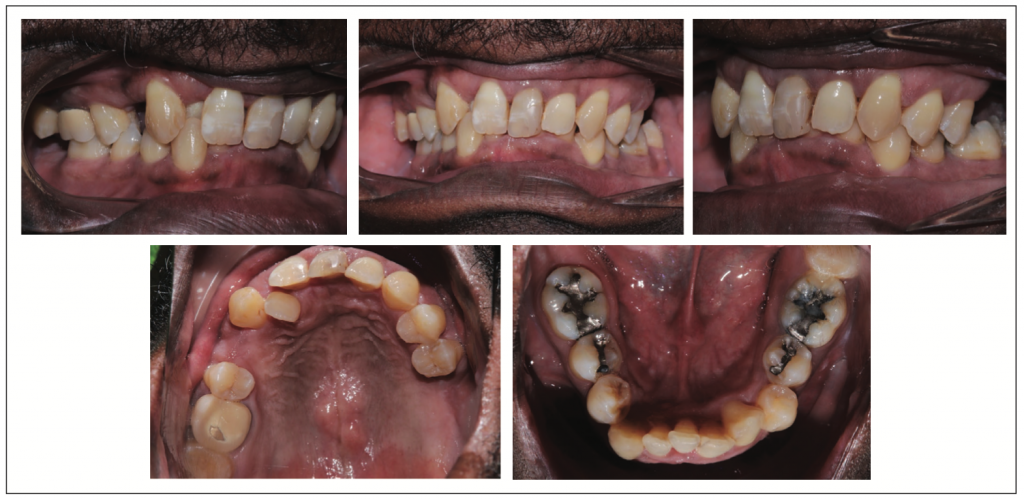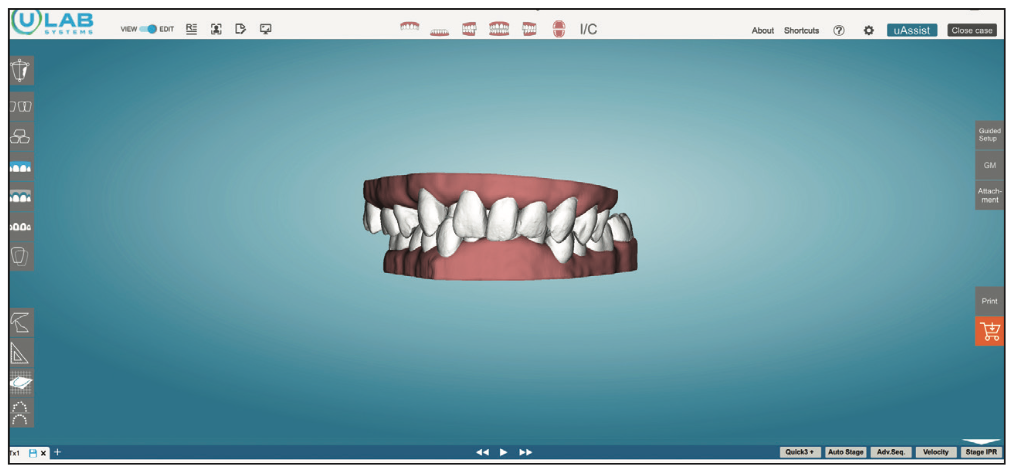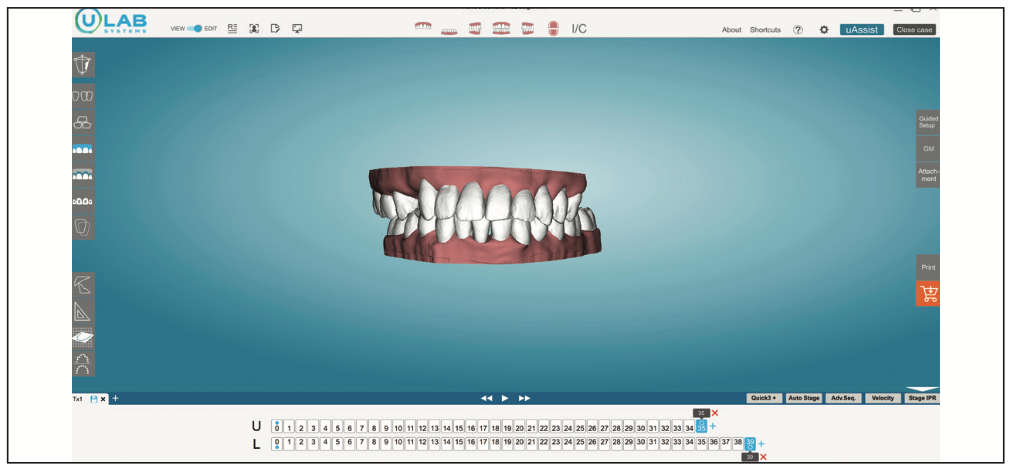INTRODUCTION
Orthodontists and restorative dentists realize the benefits of combining their expertise on complex restorative cases. Digital tools now streamline and enhance the communication on collaborative restorative dental cases, reducing time spent creating, understanding, and communicating treatment plans. Intraoral scanners facilitate sharing of digital records, including STL files that are transformed in treatment planning software into 3D representations of the progression from current to final patient outcomes.
Research supports the theory that digital tools improve the interdisciplinary orthodontic treatment of adults.1 These digital tools help clinicians visualize the outcome and determine the degree and direction of the tooth movement necessary.2
If a picture is worth a thousand words, a 3D physical model is worth exponentially more. The ability of the restorative dentist to scan new patients allows orthodontists to use those scans with sophisticated software to digitally move the teeth to the best possible occlusion within the biological bounds according to the orthodontist’s training and experience. This 3D vision can be sent electronically to the restorative dentist in the form of a video or by courier/personal delivery in the form of a 3D printed model. In addition to presenting the case to the dentist, it serves as a patient education tool and displays the importance of orthodontics to create improved predictability and stability for the restorative portion of the case. This article outlines the process of designing, printing, and presenting these 3D physical models, also known as the 3D treatment letter.
TRADITIONAL COMMUNICATION
Written treatment plans are the traditional method of collaboration on interdisciplinary cases, supplemented by in-person meetings when necessary.
Research suggests that orthodontists and general dentists have differing opinions about how well orthodontists communicate using various forms of media and that collaborating dentists should determine the optimal method of communication on a case-by-case basis.3 It is inherently challenging to communicate 3D orthodontic movement in written format. It can be time-intensive for the orthodontist to wordsmith a letter that thoroughly explains a complex treatment plan as well as for the dentist to absorb and then re-communicate to a patient. It may be especially challenging for dentists new to collaborating with an orthodontist to visualize the predicted tooth movement from written communication.
OPTIMIZED COMMUNICATION
Straighten Up Orthodontics in Clearwater, Fla, created a visualized treatment objective (VTO) workflow in the form of a 3D treatment letter (a 3D printed model showing an anticipated final, pre-restorative result) to address these challenges. Using tooth-movement software, the orthodontist can design and print the equivalent of a digital wax-up of the anticipated final position of the teeth and occlusion after the completion of orthodontic treatment.4 The VTO can be shared digitally, hand-delivered, or shipped to the dentist’s office. The referring dentist can receive the 3D model of the orthodontic result in less than a week.
The VTO technique allows the referring dentist to see 3D renderings of the orthodontic solutions to their restorative challenges in a physical model. As a result, dentists can visualize the treatment planning results in days instead of months or years. The dentist can use the model to effectively show the patient the anticipated treatment outcome and communicate the importance of ideal pre-restorative occlusion. A realistic physical representation demonstrates this more efficiently and more thoroughly than words and diagrams. With a VTO in hand, the dentist and patient can picture the rationale for orthodontic treatment. Research suggests that the VTO mockup is realistic5 because orthodontists create clear aligners with the same software that rendered the VTO, and they plan treatment according to a deep orthodontic understanding of predictable tooth movements.
The VTO has proven to be a powerful tool in patient education, resulting in increased treatment acceptance. Often, the patient sees the model, understands the importance of occlusion to the restorative case, and can easily imagine the final results. In some cases, the patient might avoid surgical interventions by leveraging the combined expertise of the orthodontist and restorative dentist.
With the electronic transfer of records, including the STL file, the patient also benefits from the elimination of an orthodontic appointment (Table 1).
Straighten Up Orthodontics has employed the 3D treatment letter with 15 local restorative dental practices. These are complex cases for dentists and orthodontists to resolve by collaborating using digital technology, and the physical model relieves a significant burden. In the authors’ orthodontic practice, patients who receive a VTO mock-up demonstrating the advantages of orthodontia as part of their restorative plans accept orthodontic treatment in 90% of the cases.
Due to the high conversion rate with these patients, the author does not charge the referring dentists nor the patient for the orthodontists’ time spent on case setup, nor for the 3D model. This reduces the dentists’ lab fees they normally pay for a diagnostic wax-up and provides a model they would normally not receive—the final post-orthodontic occlusion in 3D model form. The cost associated with producing the VTO and models consists primarily of the time spent by the orthodontist setting up the case. An orthodontist accustomed to using treatment planning software can plan a complex case as quickly as drafting a letter. In addition, there are some costs associated with printing the model itself. Patients who receive the VTO or model appear less likely to seek second opinions due to the problem-solving approach of a strong restorative team.
WORKFLOW FOR THE VTO
Here is an example of a streamlined process for communicating using a 3D printed VTO:
1. The restorative dentist sends the STL files with a restorative treatment plan to the orthodontist. (In some cases, the patient may come to the orthodontic practice for a formal consultation and digital impression.)
2. The orthodontist creates the orthodontic pre-restorative setup of the case in the uDesign treatment planning software (uLab Systems).
3. The orthodontist or orthodontic staff generates the VTO video and/or 3D printed models, ideally printing the initial and final VTO models for the dentist.
4. The orthodontist sends the 3D treatment letter in a branded box to the dentist.
5. The restorative dentist then uses the 3D-printed models to show the anticipated orthodontic outcome. The general dentist may complete a digital wax-up on a second set of 3D models to show the patient the final anticipated prosthodontic outcome.
With the support of AI and fluency with the digital tools, setup time is streamlined; the orthodontist will typically spend between 5 and 10 minutes creating the VTO digital workup treatment plan. The lab tech then adds articulator attachments to the model and adds the models to the normal 3D print workflow of the office.
The model is printed with articulator attachments to allow the dentist to analyze the case in the proper occlusion. These are typically complex cases, and having an articulator solution for the printed models improves the repeatability of the dentist evaluating the case. Advanced articulated systems enable the models to simulate natural jaw movement, including protrusion, mediotrusion, and laterotrusion.6
SUCCESS STORY USING A VTO
Restorative-orthodontic cases are, by their very nature, complex. The following is a typical case that benefited from an interdisciplinary approach. A patient presented to their general dentist with an anterior crossbite at tooth No. 7, supraerupted teeth Nos. 2 and 18, and multiple missing teeth (Figure 1). The patient expressed interest in correcting the anterior crossbite, aligning teeth, and replacing missing teeth. After reviewing the models, the dentist realized the case required an orthodontist to correct the crossbite, intrude supererupted molars, and create proper spacing for restorative work. For the dentist, the questions became “What can the orthodontist do with this case? What limitations does the case present that the ortho cannot overcome and that will alter the restorative treatment plan?” The dental office was able to share a folder with the STL files and patient photos with the orthodontist. Based on this patient information, an orthodontic mockup was created using uLab software and printed for the dentist to use during his treatment plan review with the patient (Figures 2 and 3). A 3D model (Figure 4) showing the case-specific benefits of orthodontic therapy encouraged the patient to pursue the orthodontic consultation and ultimately accept treatment.

Figure 1. Initial photos of the pre-restorative case. The patient presented with an anterior crossbite on No. 7, supraerupted teeth Nos. 2 and 18, and a missing lower incisor.

Figure 2. The case was set up in uDesign treatment planning software (uLab Systems), ready to create a visualized treatment objective (VTO) and export video.
CONCLUSION
The 3D VTO is a revolutionary concept designed to enhance communication between the orthodontist; restorative dentist; and, most importantly, the patient. Rather than using conventional impression material, the digital intraoral scanner provides a much more comfortable patient experience to obtain a full-mouth impression. The digital information can be used to help the orthodontist and restorative dentist discuss and treatment plan ideal tooth positions for the final restorative outcome. When completing the initial treatment consultation, conveying the restorative outcome to the patient can be challenging. In preparation for a large restorative case presentation, a VTO is used to help show the starting dental position of teeth as well as the anticipated tooth position postorthodontic treatment. From this evaluation, a preliminary wax-up can be completed to establish a predictable final prosthetic result. Combining both the anticipated orthodontic and restorative outcomes with the baseline dental condition helps the patient visualize how his or her “dream smile” will be obtained.
When orthodontists work with dentists on complex restorative cases, communication is essential to treatment acceptance. However, letters, phone calls, and in-person meetings do not always succeed in showing the dentist and the patient what is possible with orthodontic treatment. Using treatment planning software to design a case and create a 3D VTO effectively shows restorative dentists and patients what orthodontics can accomplish to enhance their restorative clinical outcomes with more predictability and stability. For Straighten Up Orthodontics, patients move forward with treatment 9 times out of 10, far superior to any referral acceptance rate obtained with traditional communication.
REFERENCES
1. Ogodescu A, Sinescu C, Ogodescu E, et al. Digital tools in the interdisciplinary orthodontic treatment of adult patients. Int J Biol Biomed Eng. 2010;4(4):97-105.
2. Shantiyai S. Comparison of Digital Treatment Setups and Final Treatment Outcomes of Class II Division 1 Malocclusions Treated with Premolar Extractions. [Master’s thesis]. Las Vegas: University of Nevada, Las Vegas; 2020. doi:10.34917/19412168
3. Bibona K, Shroff B, Best AM, et al. Communication practices and preferences between orthodontists and general dentists. Angle Orthod. 2015;85(6):1042–50. doi:10.2319/111714-826.1
4. Asakawa S, Al-Musaallam T, Handelman CS. Nonextraction treatment of a Class II deepbite malocclusion with severe mandibular crowding: visualized treatment objectives for selecting treatment options. Am J Orthod Dentofacial Orthop. 2008;133(2):308–16. doi:10.1016/j.ajodo.2006.08.018
5. Lombardo L, Arreghini A, Ramina F, et al. Predictability of orthodontic movement with orthodontic aligners: a retrospective study. Prog Orthod. 2017;18(1):35. doi:10.1186/s40510-017-0190-0
6. xSNAP. First model with printable articulator. Accessed September 22, 2022. https://www.x-snap.net/index_en.html
ADDITIONAL READING
1. Adel SM, Vaid NR, El-Harouni N, et al. Tip, Torque and Rotations: How accurately do digital superimposition software packages quantify tooth movement? Prog Orthod. 2022;23(1):8. doi:10.1186/s40510-022-00402-x
2. McLaughlin RP, Bennett JC. The dental VTO: an analysis of orthodontic tooth movement. J Clin Orthod. 1999;33(7):394-403.
3. Melsen B, Fiorelli G. Chapter 5: Treatment Planning: The 3D VTO. In: Melsen B, Luzi C, eds. Adult Orthodontics. 2nd ed. Wiley-Blackwell; 2022: 65- 78. doi:10.1002/9781119775805.ch5
ABOUT THE AUTHORS
Dr. Layman earned his DMD degree at the Medical University of South Carolina (MUSC). As an orthodontic resident at Vanderbilt University, he was part of a university-wide team charged with creating the EMR system for the Vanderbilt Medical Center. After starting a paperless and digital orthodontic office in 2004, Dr. Layman completed his MBA at the Wharton School, University of Pennsylvania. He is a Diplomate of the American Board of Orthodontics and Fellow of the American College of Dentists. He has conducted seminars for the Vanderbilt Orthodontic Program, MUSC orthodontic program, and the Dawson Academy. He currently teaches at the University of Florida. Dr. Layman opened Straighten Up Orthodontics in 2005 and co-founded the nonprofit Community Dental Clinic in 2011. He can be reached at straightenup@me.com.
Dr. Kiskaddon earned his DMD degree at the University of Florida College of Dentistry. He attended the University of Florida College of Dentistry’s “Advanced Education in General Dentistry” residency in Seminole, Fla, for further training in complex restorative dentistry. Currently, he practices comprehensive general dentistry in Clearwater, Fla. Dr. Kiskaddon also serves as faculty and enjoys teaching dental residents at the University of Florida College of Dentistry. He can be reached at drkiskaddon@cdadental.com
Disclosure: Dr. Layman is a key opinion leader and speaker for uLab Systems and has a financial interest in the company. Dr. Kiskaddon reports no disclosures.















